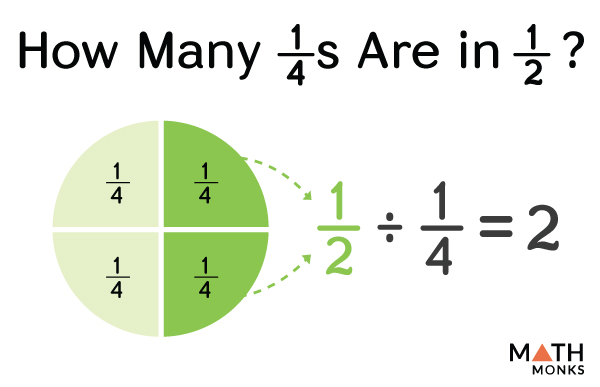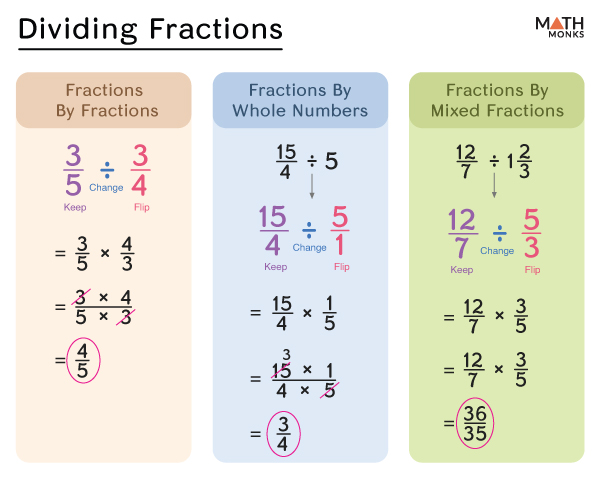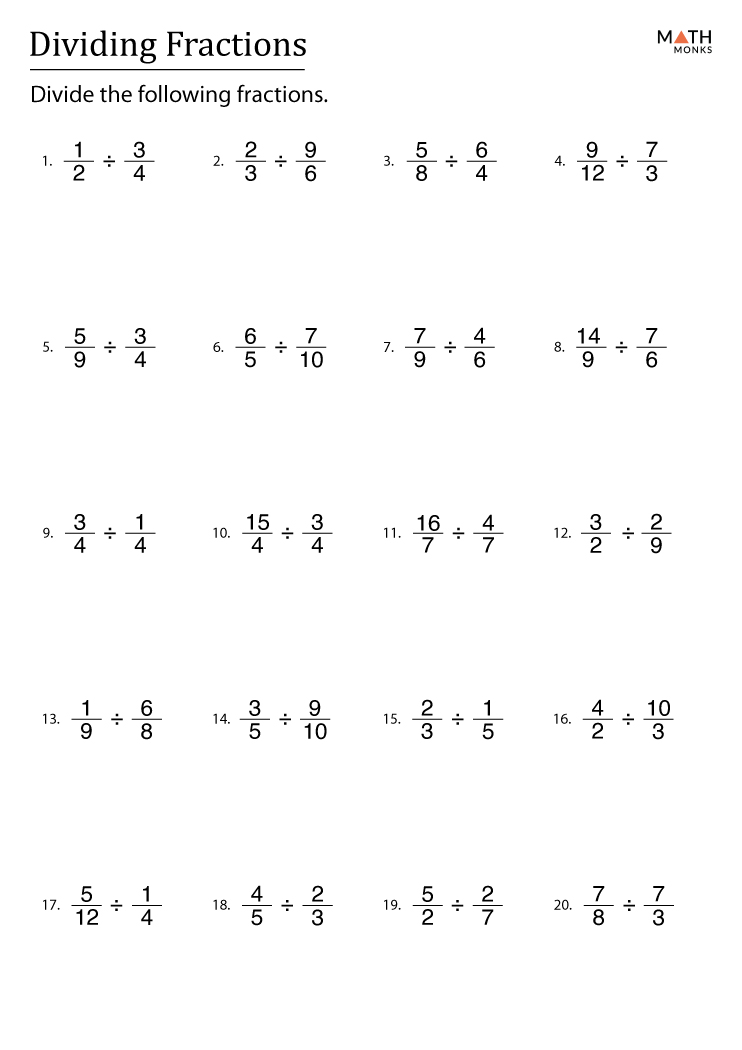Like multiplication, division of fractions also involves four basic steps:
- Finding the reciprocal or the multiplicative inverse of the second fraction (the divisor)
- Changing the sign from division to multiplication
- Multiplying the first fraction by the reciprocal fraction
- Simplifying or reducing the quotient to its lowest terms if needed.
If a fraction ${\dfrac{a}{b}}$ is divided by another fraction ${\dfrac{x}{y}}$, then it is written as
${\dfrac{a}{b}\div \dfrac{x}{y}}$ = ${\dfrac{a}{b}\times \dfrac{y}{x}}$
This implies ${\dfrac{a\times y}{b\times x}}$ = ${\dfrac{ay}{bx}}$
Now, let us divide ${\dfrac{3}{5}}$ by ${\dfrac{3}{4}}$
${\dfrac{3}{5}\div \dfrac{3}{4}}$
Finding the Reciprocal
The second fraction is ${\dfrac{3}{4}}$
Turning ${\dfrac{3}{4}}$ upside down, we get the reciprocal
${\dfrac{3}{4}}$ becomes ${\dfrac{4}{3}}$
Changing the Sign
The sign is changed from division to multiplication
${\dfrac{3}{5}\times \dfrac{4}{3}}$
Multiplying the First Fraction by the Reciprocal
= ${\dfrac{3\times 4}{5\times 3}}$
= ${\dfrac{4}{5}}$
Simplifying
Since ${\dfrac{4}{5}}$ is already in the simplified form.
Thus, the quotient is ${\dfrac{4}{5}}$
Visual Representation
Now, if we need to find 12 ÷ 4, it intends to find “How many 4s are there in 12?”
Since 4 × 3 = 12, we find three 4s in 12. Thus, the answer is 3
Similarly, ${\dfrac{1}{2}\div \dfrac{1}{4}}$ means, “How many ${\dfrac{1}{4}}$s are in ${\dfrac{1}{2}}$?”
Let us use a circle to get the result.
With Whole Numbers
To divide a fraction by a whole number, we multiply the fraction by the reciprocal of the whole number and then simplify the quotient to its lowest terms if needed.
Let us divide ${\dfrac{15}{4}}$ by ${5}$
${\dfrac{15}{4}\div 5}$
Finding the Reciprocal
The reciprocal of ${5}$ is ${\dfrac{1}{5}}$
Changing the Sign
= ${\dfrac{15}{4}\times \dfrac{1}{5}}$
Multiplying the First Fraction by the Reciprocal
= ${\dfrac{15\times 1}{4\times 5}}$
Simplifying
= ${\dfrac{5\times 3\times 1}{4\times 5}}$
= ${\dfrac{3}{4}}$
Thus, the quotient is ${\dfrac{3}{4}}$
With Decimals
To divide a fraction by a decimal number, we first convert the given decimal to its equivalent fraction and then divide it by the given fraction.
Let us divide the fraction ${\dfrac{5}{6}}$ by the decimal number ${0\cdot 2}$
Converting the Decimal into Fraction
Converting ${0\cdot 2}$ into its equivalent fraction, we get
${0\cdot 2}$ = ${\dfrac{2}{10}}$ = ${\dfrac{1}{5}}$
Now, dividing ${\dfrac{5}{6}}$ by ${\dfrac{1}{5}}$, we have
${\dfrac{5}{6}\div \dfrac{1}{5}}$
Finding the Reciprocal
The reciprocal of ${\dfrac{1}{5}}$ is ${\dfrac{5}{1}}$
Changing the Sign
= ${\dfrac{5}{6}\times \dfrac{5}{1}}$
Multiplying the First Fraction by the Reciprocal
= ${\dfrac{5\times 5}{6\times 1}}$
= ${\dfrac{25}{6}}$, which is in the simplest form.
Thus, the quotient is ${\dfrac{25}{6}}$
With Mixed Numbers
To divide a fraction by a mixed number, we first convert the mixed number into an improper fraction and then follow the other steps.
If ${\dfrac{12}{7}\div 1\dfrac{2}{3}}$
Converting the Mixed Number into an Improper Fraction
Converting ${1\dfrac{2}{3}}$ into an improper fraction,
${1\dfrac{2}{3}}$ = ${\dfrac{\left( 1\times 3\right) +2}{3}}$ = ${\dfrac{5}{3}}$
Now, we have ${\dfrac{12}{7}\div \dfrac{5}{3}}$
Finding the Reciprocal
The reciprocal of ${\dfrac{5}{3}}$ is ${\dfrac{3}{5}}$
Changing the Sign
${\dfrac{12}{7}\times \dfrac{3}{5}}$
Multiplying the First Fraction by the Reciprocal
= ${\dfrac{12\times 3}{7\times 5}}$
= ${\dfrac{36}{35}}$, which is in the simplest form.
Thus, the quotient is ${\dfrac{36}{35}}$
Here is a summary of what we learned so far.
Solved Examples
![]() Divide: ${\dfrac{25}{3}}$ by ${\dfrac{3}{4}}$
Divide: ${\dfrac{25}{3}}$ by ${\dfrac{3}{4}}$
Solution:
![]()
${\dfrac{25}{3}\div \dfrac{3}{4}}$
= ${\dfrac{25}{3}\times \dfrac{4}{3}}$
= ${\dfrac{25\times 4}{3\times 3}}$
= ${\dfrac{100}{9}}$
= ${11\dfrac{1}{9}}$
![]() Find the quotient: ${\dfrac{3}{4}\div 2}$
Find the quotient: ${\dfrac{3}{4}\div 2}$
Solution:
![]()
Here, ${\dfrac{3}{4}\div 2}$
= ${\dfrac{3}{4}\times \dfrac{1}{2}}$
= ${\dfrac{3\times 1}{4\times 2}}$
= ${\dfrac{3}{8}}$
Thus, the quotient is ${\dfrac{3}{8}}$



